Hope XCR Pro X2 and E4 Brakes
Stated Weight:
- XCR Pro X2: 199 grams
- XCR Pro E4: n/a
MSRP:
- XCR Pro X2: $253 / £200.00 / €250.00
- XCR Pro E4: $285 / £225 / €285
Blister’s Measured Weight: 229 and 252 g (XCR Pro E4, uncut hoses, no adapters or rotors)
Bolted to: BTR Ranger
Reviewer: 6’, 170 lbs / 183 cm, 77.1 kg
Test Location: Washington
Test Duration: 6 months
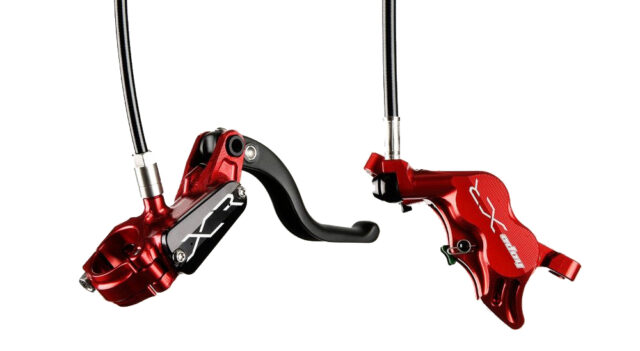
Intro
Hope has historically offered a bunch of options for mixing and matching their various brake calipers and levers in order to give folks options for dialing in the amount of power they need, the features they want, and saving weight when it makes sense. Now there’s a new option in the lineup — the XCR Pro lever with an E4 caliper — as well as an expanded list of color options for the whole XCR Pro lineup.
Design
Hope’s Tech 4 line of brakes — the X2, E4, and V4 — have been out for a couple of years now. They use the same fully-featured lever assembly, with tool-free reach and contact point adjusters, paired with your choice of an XC-oriented two-piston caliper (X2), a four-piston Trail / Enduro one (E4), or a bigger, more powerful Enduro / DH four-piston caliper (V4). We’ve been big fans of the Tech 4 V4 in particular; check out our Full Review and our conversation with Hope brake engineer Sam Gibbs for a whole lot more on those.





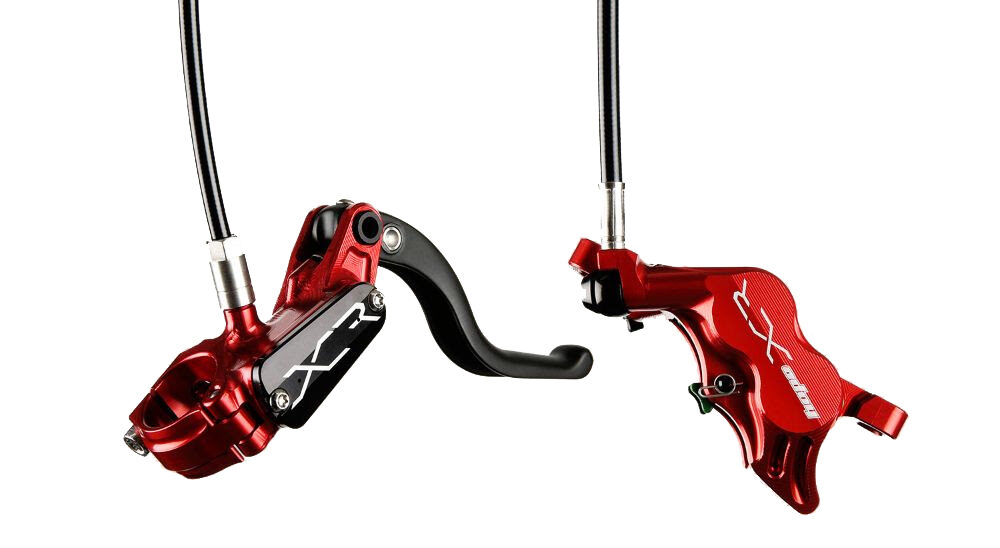
So with those updates, Hope’s full mountain bike brake range is as follows:
- XCR Pro X2: XCR Pro Lever + X2 Caliper
- Tech 4 X2: Tech 4 Lever + X2 Caliper
- XCR Pro E4: XCR Pro Lever + E4 Caliper
- Tech 4 E4: Tech 4 Lever + E4 Caliper
- Tech 4 V4: Tech 4 Lever + V4 Caliper
Hope says that the XCR Pro lever provides a bit less power than the Tech 4 one, given the same caliper at the other end, so it’ll be interesting to see how the XCR Pro E4 comes together on the trail. The E4 caliper has about 6% more piston area (and therefore hydraulic leverage) than the X2 one, and presumably somewhat improved heat management due to its added bulk, larger pads, etc. We’ll just need to start testing a set to find out — and will be doing just that very soon.
Some Questions / Things We’re Curious About
(1) Given the apparent overlap between the Tech 4 X2, XCR Pro E4, and Tech 4 E4, how should folks think about the tradeoffs between them, and who’s going to be best suited by which version?
(2) How does the feel of the XCR Pro lever compare to that of the Tech 4 one, and how much does the power differ between the XCR Pro E4 and the Tech 4 E4?
(3) And how does the XCR Pro E4 compare to the rest of the Trail-bike brakes out there?
FULL REVIEW
A lot of the recent developments in MTB brakes have come at the bigger, more gravity-oriented end of the spectrum. As Enduro and DH bikes are being ridden harder and faster than ever before, riders have needed more powerful brakes to cope with those demands — especially as big 29’’ wheels have become commonplace.
Hope’s XCR Pro E4 brakes, though, are aimed at shorter-travel Trail bikes, and while Hope freely admits that the XCR Pro lever produces less power than the Tech 4 one when paired with the same caliper, the XCR Pro lever saves about 30 grams per side and features a more sleek, pared-down lever design. So would the XCR Pro E4s just be for weight weenies who are chasing every spare gram, or would there be other upsides to the simpler XCR Pro lever?
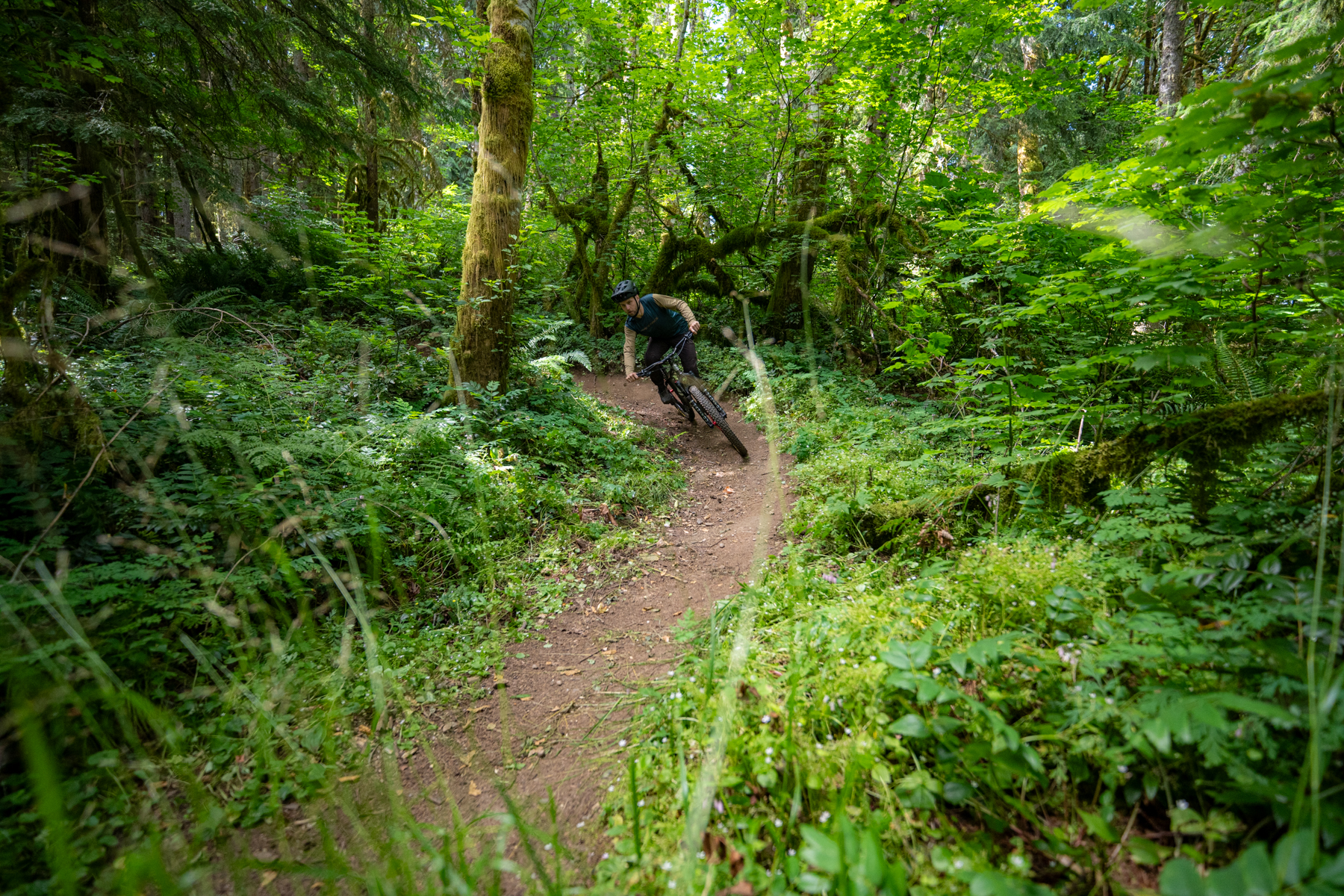
On the Trail
The first thing that stands out about the XCR Pro E4s is their lever feel. The free stroke is quite light and relatively short, before ramping quickly but smoothly to a very firm bite point. I can’t think of another modern brake that manages to have both a free stroke this light (only the Hayes Dominion A4 / T4 beat the XCR Pro E4 on that first point) and such a clearly defined, solid bite point. It’s excellent.
Describing the way that the XCR Pro E4s deliver their power, and how the lever feels when doing it is a little tricky, but it’s also their biggest strong suit. The best way I can put it is that the early part of the free stroke is quite light, the bite point once the brake is fully engaged is notably firm and solid, and the ramp-up between the two truly stands out for being smooth, consistent, and predictable. If you’ve found certain other brakes — particularly more powerful ones — to be harder to modulate than you’d like, the XCR Pro E4s are an especially good option.
I also quite like the shape of the XCR Pro lever blade. It’s a little thinner and considerably more rounded than the Tech 4 one, producing less of a flat-feeling front face. And while the hook on the end isn’t super deep, it’s pronounced enough to feel reasonably secure, even when set up to be held at the very end of the blade. The reach adjuster uses a 2 mm Allen wrench but it’s easily accessible on the front of the lever assembly (including with a multi-tool) and has nice, clearly defined detents that keep it from moving from the desired setting. I tend to run my brake levers relatively close to the bar, but the XCR Pro levers have plenty of room to go even closer than my preferred setting, and still have plenty of headroom on the outward end of the range. There’s no contact point adjuster, but I haven’t missed it at all.
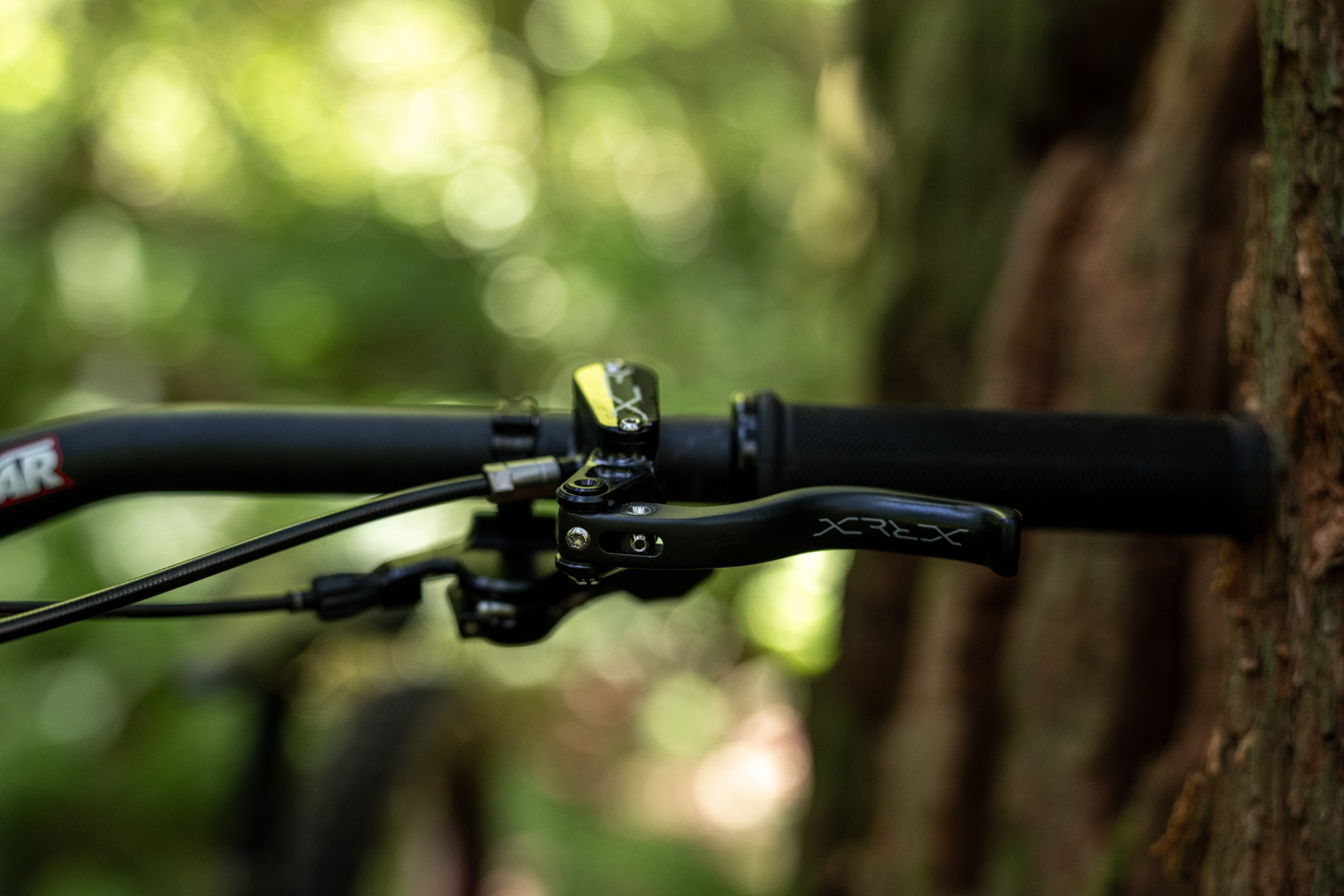
The XCR Pro E4s are an interesting contrast to the SRAM Maven brakes that I just reviewed. I like both brakes quite a bit, but for very different reasons and for different use cases. The Mavens are massively more powerful, way heavier, and offer far better heat management and fade resistance than the XCR Pro E4s when subjected to very long, steep brake-drag-y descents. But by worrying less about maximizing power, Hope has managed to deliver especially nice ergonomics and feel.
And that makes some sense. We spoke with Hope engineer Sam Gibbs when the Tech 4 brakes launched a couple of years ago, and a lot of that discussion covered the many competing desirable traits for a brake. Designing a good one requires making the best possible tradeoffs for the intended use case rather than being able to optimize every single variable individually. Increasing power means increasing the total leverage, which tends to lengthen the free stroke and soften the bite point; reducing the piston rollback (and thus pad-to-rotor clearance with the brakes disengaged) helps tighten things up, but makes it harder to get the brakes rub-free; adding a cam mechanism to the lever assembly can deliver a shorter free stroke but tends to lead to a stiffer feeling lever and less consistent power delivery; and so on.
SRAM has done a good job of delivering massive power with a not-super-long free stroke and solid bite point with the Mavens, but their lever feel and modulation are not their strongest suits; the XCR Pro E4s swing in the other direction, and the lever feel that they’re able to deliver by making different tradeoffs is stellar.

I bring the Maven comparison up not because anybody is actually going to cross-shop those brakes with XCR Pro E4s, but because it helps illustrate what the XCR Pro E4s do best. The lever feel and ease of modulation on the XCR Pro E4s are truly exceptional, and while they’re nowhere close to being the absolute most powerful brakes on the market, they’re pretty solid for a lighter-duty Trail bike brake. For reference, I’d put the XCR Pro E4s somewhere between Shimano XT two- and four-piston brakes but closer to the latter, and pretty close to SRAM Codes in terms of outright power. Pairing the E4 caliper with the Tech 4 lever bumps up the power a little bit, but also produces a longer free stroke and softer bite point, and isn’t quite as easy to modulate cleanly. I’d rate the power difference between the XCR Pro lever and the Tech 4 one (all else being equal) as roughly comparable to going up one rotor size.
While I personally don’t care that much about the weight savings of the XCR Pro lever compared to the Tech 4 one, there are other very good reasons to go for the XCR Pro E4 combo on a bike where you don’t need the absolute most powerful brakes that you can get your hands on. The XCR Pro E4s are still going to be plenty powerful for a lot of folks, and the smooth, consistent, easily controlled way that they deliver their power is special.
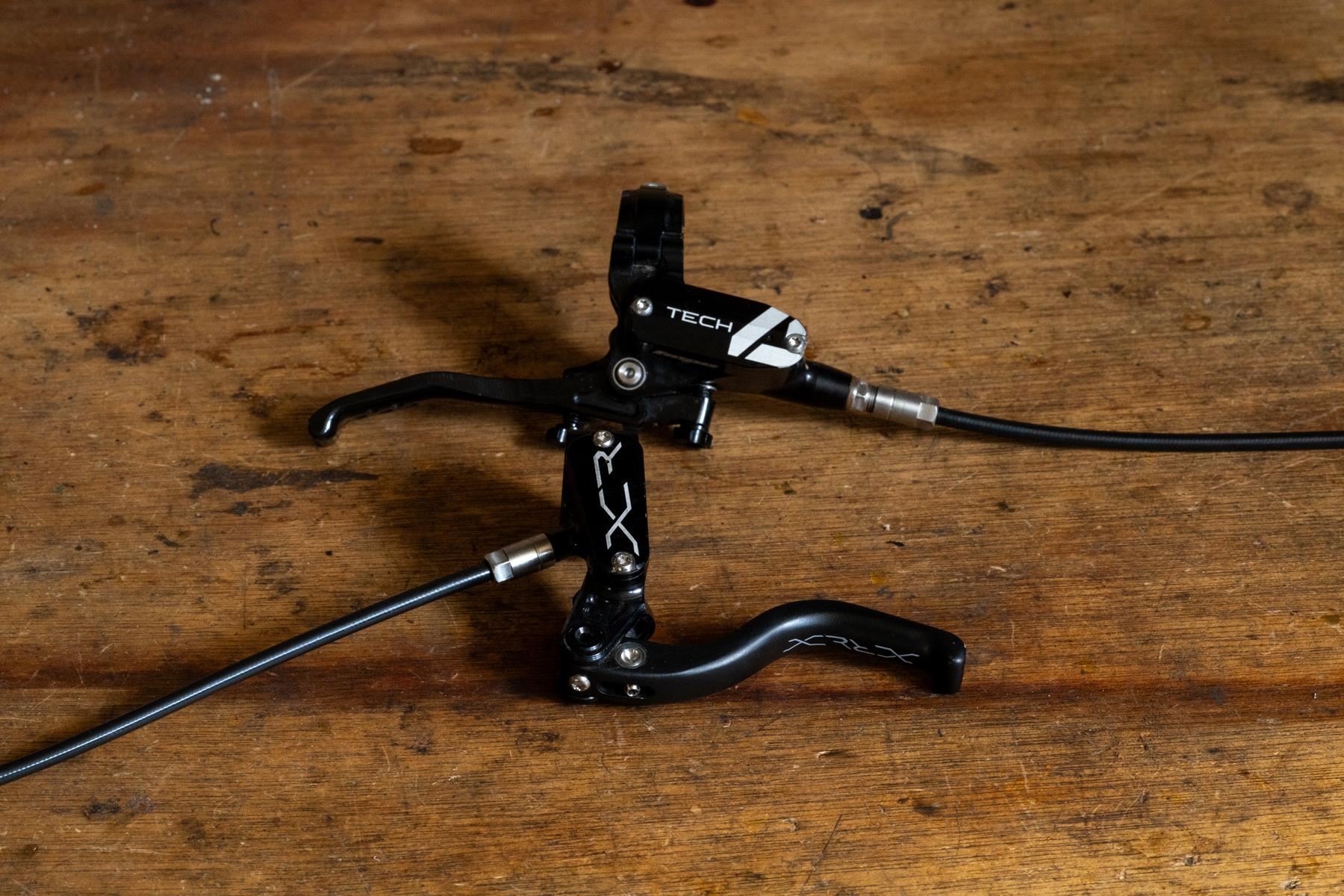
As per usual for Hope’s two-piece rotors, the ones I’ve been using with the XCR Pro E4s (in 200 mm front / 180 mm rear sizes) make an audible ticking noise as they cool off, due to the disparate thermal expansion of the stainless steel brake track and the aluminum carrier. I’ve never minded much — it’s not very loud and really only comes up when you stop riding / putting heat into the brakes rather than being noticeable while on the move — but folks who really want to be rid of every possible on-bike noise should be warned. Hope makes more conventional one-piece rotors if you’re really worried (though I’ve yet to try those) and any number of other brands’ rotors work fine, too. I’ve also run Galfer centerlock rotors (203 mm front / 180 mm rear) with the XCR Pro E4s and those have been a good match.
Maintenance
I had an easy time getting a good bleed on the XCR E4s right out of the gate, and haven’t needed to touch them since. Hope’s top-down bleed process can be a little messy but it’s straightforward to do, and unlike the Tech 4 V4s, I didn’t have any trouble getting the last couple of tiny bubbles out of the XCR E4s on the first try. The lever feel has remained consistent, and I’ve had no signs of an inconsistent bite point or any other performance issues.
The only (minor) maintenance-related issue I had with the XCR E4s is that I was lazy with my initial bedding in process, and wound up getting some light squeaking from the brakes as a result. Scuffing the pads with coarse sandpaper and cleaning everything up with isopropyl alcohol to reset them did the trick, and with a little care to bed the pads in properly the second time around, the noise hasn’t come back. Hope’s Race pads seem to be somewhat sensitive to getting bedded in properly, but doing so is fairly quick and easy — just ride up and down the street, drag the brakes to a near (but not complete) stop, and repeat a handful of times until their power stops ramping up.
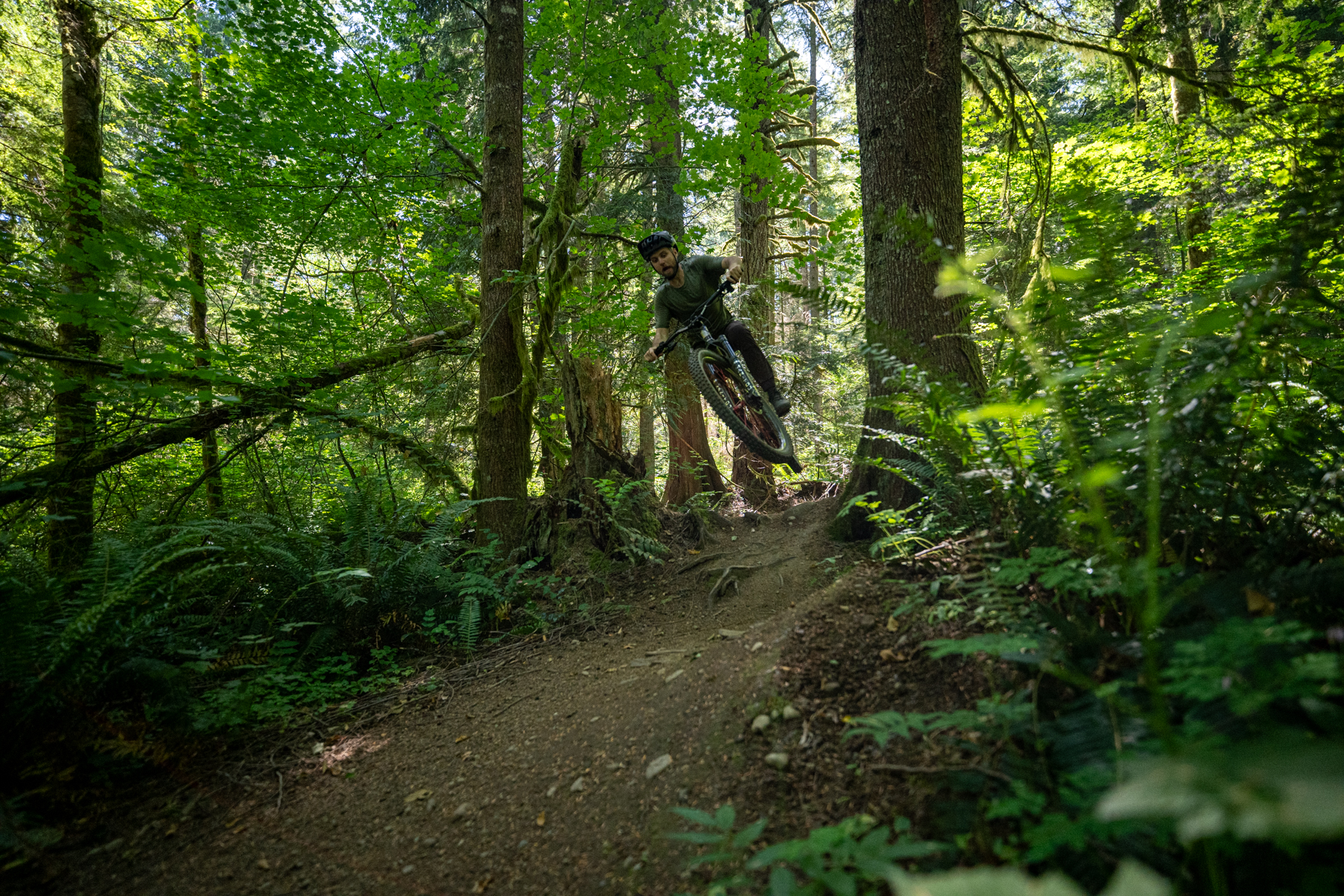
I’ve only run the stock green “Race” pads in the XCR Pro E4s, but have tested that same pad compound against a wider variety of options in the Tech 4 V4s, and generally like it quite well. The Race pads offer very good power, are quick to get up to temperature (and work pretty well when cold), and have been quiet when bedded in properly. Their downsides are that they aren’t super long-lasting (Hope’s red “All Conditions” pads and, especially, the purple E-Bike ones are harder wearing) and the Race pads only perform okay in wet conditions. The All-Condition pads aren’t quite as powerful in more ideal conditions as the Race pads and are a little noisier, but they’re more consistent when things get really wet.
Bottom Line
Gravity-oriented MTB brakes have been growing ever more powerful in recent years — Hope’s Tech 4 V4s are a prime example of that — and while that’s been a welcome development, the XCR E4 shows the merit of taking a different approach for bikes that won’t be subjected to ultra-long and steep descents all the time. The XCR E4s are quite light and offer solid power, but what really makes them stand out is how nice their lever feel and modulation are. By using a simpler lever without a leverage-altering cam, Hope has made a brake with an especially smooth, consistent lever feel, a light free stroke and crisp bite point, and enough power for a lot of folks on short- or mid-travel Trail bikes. If you’ve found a lot of more powerful brakes to be hard to modulate and / or have a clunkier, less consistent lever feel than you’d like, the XCR Pro E4s deserve a look.
